Hold down the T key for 3 seconds to activate the audio accessibility mode, at which point you can click the K key to pause and resume audio. Useful for the Check Your Understanding and See Answers.
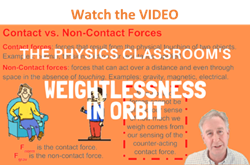 Astronauts who are orbiting the Earth often experience sensations of weightlessness. These sensations experienced by orbiting astronauts are the same sensations experienced by anyone who has been temporarily suspended above the seat on an amusement park ride. Not only are the sensations the same (for astronauts and roller coaster riders), but the causes of those sensations of weightlessness are also the same. Unfortunately however, many people have difficulty understanding the causes of weightlessness.
Astronauts who are orbiting the Earth often experience sensations of weightlessness. These sensations experienced by orbiting astronauts are the same sensations experienced by anyone who has been temporarily suspended above the seat on an amusement park ride. Not only are the sensations the same (for astronauts and roller coaster riders), but the causes of those sensations of weightlessness are also the same. Unfortunately however, many people have difficulty understanding the causes of weightlessness.
What Do You Believe?
The cause of weightlessness is quite simple to understand. However, the stubbornness of one's preconceptions on the topic often stand in the way of one's ability to understand. Consider the following multiple choice question about weightlessness as a test of your preconceived notions on the topic:
|
Test your preconceived notions about weightlessness:
Astronauts on the orbiting space station are weightless because...
a. there is no gravity in space and they do not weigh anything.
b. space is a vacuum and there is no gravity in a vacuum.
c. space is a vacuum and there is no air resistance in a vacuum.
d. the astronauts are far from Earth's surface at a location where gravitation has a minimal effect.
|
If you believe in any one of the above statements, then it might take a little rearrangement and remapping of your brain to understand the real cause of weightlessness. As is the case on many topics in Physics, some unlearning must first be done before doing the learning. Put another way: it's not what you don't know that makes learning physics a difficult task; it's what you do know that makes learning physics a difficult task. So if you do have a preconception (or a strong preconception) about what weightlessness is, you need to be aware of that preconceived idea. And as you consider the following alternative conception about the meaning of weightlessness, evaluate the reasonableness and logic of the two competing ideas.
Contact versus Non-Contact Forces
Before understanding weightlessness, we will have to review two categories of forces - contact forces and action-at-a-distance forces. As you sit in a chair, you experience two forces - the force of the Earth's gravitational field pulling you downward toward the Earth and the force of the chair pushing you upward. The upward chair force is sometimes referred to as a normal force and results from the contact between the chair top and your bottom end. This normal force is categorized as a contact force. Contact forces can only result from the actual touching of the two interacting objects - in this case, the chair and you. The force of gravity acting upon your body is not a contact force; it is often categorized as an action-at-a-distance force. The 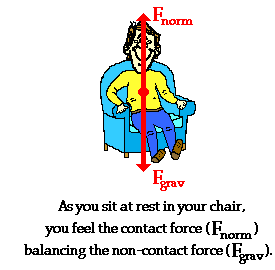 force of gravity is the result of your center of mass and the Earth's center of mass exerting a mutual pull on each other; this force would even exist if you were not in contact with the Earth. The force of gravity does not require that the two interacting objects (your body and the Earth) make physical contact; it can act over a distance through space. Since the force of gravity is not a contact force, it cannot be felt through contact. You can never feel the force of gravity pulling upon your body in the same way that you would feel a contact force. If you slide across the asphalt tennis court (not recommended), you would feel the force of friction (a contact force). If you are pushed by a bully in the hallway, you would feel the applied force (a contact force). If you swung from a rope in gym class, you would feel the tension force (a contact force). If you sit in your chair, you feel the normal force (a contact force). But if you are jumping on a trampoline, even while moving through the air, you do not feel the Earth pulling upon you with a force of gravity (an action-at-a-distance force). The force of gravity can never be felt. Yet those forces that result from contact can be felt. And in the case of sitting in your chair, you can feel the chair force; and it is this force that provides you with a sensation of weight. Since the upward normal force would equal the downward force of gravity when at rest, the strength of this normal force gives one a measure of the amount of gravitational pull. If there were no upward normal force acting upon your body, you would not have any sensation of your weight. Without the contact force (the normal force), there is no means of feeling the non-contact force (the force of gravity).
force of gravity is the result of your center of mass and the Earth's center of mass exerting a mutual pull on each other; this force would even exist if you were not in contact with the Earth. The force of gravity does not require that the two interacting objects (your body and the Earth) make physical contact; it can act over a distance through space. Since the force of gravity is not a contact force, it cannot be felt through contact. You can never feel the force of gravity pulling upon your body in the same way that you would feel a contact force. If you slide across the asphalt tennis court (not recommended), you would feel the force of friction (a contact force). If you are pushed by a bully in the hallway, you would feel the applied force (a contact force). If you swung from a rope in gym class, you would feel the tension force (a contact force). If you sit in your chair, you feel the normal force (a contact force). But if you are jumping on a trampoline, even while moving through the air, you do not feel the Earth pulling upon you with a force of gravity (an action-at-a-distance force). The force of gravity can never be felt. Yet those forces that result from contact can be felt. And in the case of sitting in your chair, you can feel the chair force; and it is this force that provides you with a sensation of weight. Since the upward normal force would equal the downward force of gravity when at rest, the strength of this normal force gives one a measure of the amount of gravitational pull. If there were no upward normal force acting upon your body, you would not have any sensation of your weight. Without the contact force (the normal force), there is no means of feeling the non-contact force (the force of gravity).
Meaning and Cause of Weightlessness
Weightlessness is simply a sensation experienced by an individual when there are no external objects touching one's body and exerting a push or pull upon it. Weightless sensations exist when all contact forces are removed. These sensations are common to any situation in which you are momentarily (or perpetually) in a state of free fall. When in free fall, the only force acting upon your body is the force of gravity - a non-contact force. Since the force of gravity cannot be felt without any other opposing forces, you would have no sensation of it. You would feel weightless when in a state of free fall.
These feelings of weightlessness are common at amusement parks for riders of roller coasters and other rides in which riders are momentarily airborne and lifted out of their seats. Suppose that you were lifted in your chair 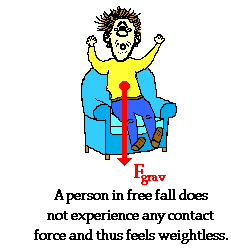 to the top of a very high tower and then your chair was suddenly dropped. As you and your chair fall towards the ground, you both accelerate at the same rate - g. Since the chair is unstable, falling at the same rate as you, it is unable to push upon you. Normal forces only result from contact with stable, supporting surfaces. The force of gravity is the only force acting upon your body. There are no external objects touching your body and exerting a force. As such, you would experience a weightless sensation. You would weigh as much as you always do (or as little) yet you would not have any sensation of this weight.
to the top of a very high tower and then your chair was suddenly dropped. As you and your chair fall towards the ground, you both accelerate at the same rate - g. Since the chair is unstable, falling at the same rate as you, it is unable to push upon you. Normal forces only result from contact with stable, supporting surfaces. The force of gravity is the only force acting upon your body. There are no external objects touching your body and exerting a force. As such, you would experience a weightless sensation. You would weigh as much as you always do (or as little) yet you would not have any sensation of this weight.
Weightlessness is only a sensation; it is not a reality corresponding to an individual who has lost weight. As you are free falling on a roller coaster ride (or other amusement park ride), you have not momentarily lost your weight. Weightlessness has very little to do with weight and mostly to do with the presence or absence of contact forces. If by "weight" we are referring to the force of gravitational attraction to the Earth, a free-falling person has not "lost their weight;" they are still experiencing the Earth's gravitational attraction. Unfortunately, the confusion of a person's actual weight with one's feeling of weight is the source of many misconceptions.
Scale Readings and Weight
Technically speaking, a scale does not measure one's weight. While we use a scale to measure one's weight, the scale reading is actually 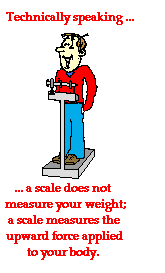 a measure of the upward force applied by the scale to balance the downward force of gravity acting upon an object. When an object is in a state of equilibrium (either at rest or in motion at constant speed), these two forces are balanced. The upward force of the scale upon the person equals the downward pull of gravity (also known as weight). And in this instance, the scale reading (that is a measure of the upward force) equals the weight of the person. However, if you stand on the scale and bounce up and down, the scale reading undergoes a rapid change. As you undergo this bouncing motion, your body is accelerating. During the acceleration periods, the upward force of the scale is changing. And as such, the scale reading is changing. Is your weight changing? Absolutely not! You weigh as much (or as little) as you always do. The scale reading is changing, but remember: the SCALE DOES NOT MEASURE YOUR WEIGHT. The scale is only measuring the external contact force that is being applied to your body.
a measure of the upward force applied by the scale to balance the downward force of gravity acting upon an object. When an object is in a state of equilibrium (either at rest or in motion at constant speed), these two forces are balanced. The upward force of the scale upon the person equals the downward pull of gravity (also known as weight). And in this instance, the scale reading (that is a measure of the upward force) equals the weight of the person. However, if you stand on the scale and bounce up and down, the scale reading undergoes a rapid change. As you undergo this bouncing motion, your body is accelerating. During the acceleration periods, the upward force of the scale is changing. And as such, the scale reading is changing. Is your weight changing? Absolutely not! You weigh as much (or as little) as you always do. The scale reading is changing, but remember: the SCALE DOES NOT MEASURE YOUR WEIGHT. The scale is only measuring the external contact force that is being applied to your body.
Now consider Otis L. Evaderz who is conducting one of his famous elevator experiments. He stands on a bathroom scale and rides an elevator up and down. As he is accelerating upward and downward, the scale reading is different than when he is at rest and traveling at constant speed. When he is accelerating, the upward and downward forces are not equal. But when he is at rest or moving at constant speed, the opposing forces balance each other. Knowing that the scale reading is a measure of the upward normal force of the scale upon his body, its value could be predicted for various stages of motion. For instance, the value of the normal force (Fnorm) on Otis's 80-kg body could be predicted if the acceleration is known. This prediction can be made by simply applying Newton's second law as discussed in Unit 2. As an illustration of the use of Newton's second law to determine the varying contact forces on an elevator ride, consider the following diagram. In the diagram, Otis's 80-kg is traveling with constant speed (A), accelerating upward (B), accelerating downward (C), and free falling (D) after the elevator cable snaps.
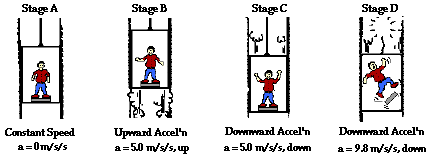
In each of these cases, the upward contact force (Fnorm) can be determined using a free-body diagram and Newton's second law. The interaction of the two forces - the upward normal force and the downward force of gravity - can be thought of as a tug-of-war. The net force acting upon the person indicates who wins the tug-of-war (the up force or the down force) and by how much. A net force of 100-N, up indicates that the upward force "wins" by an amount equal to 100 N. The gravitational force acting upon the rider is found using the equation Fgrav = m*g.
|
Stage A

|
Stage B

|
Stage C

|
Stage D

|
|
Fnet = m*a
Fnet = 0 N
|
Fnet = m*a
Fnet = 400 N, up
|
Fnet = m*a
Fnet = 400 N, down
|
Fnet = m*a
Fnet = 784 N, down
|
|
Fnorm equals Fgrav
Fnorm = 784 N
|
Fnorm > Fgrav by 400 N
Fnorm = 1184 N
|
Fnorm < Fgrav by 400 N
Fnorm = 384 N
|
Fnorm < Fgrav by 784 N
Fnorm = 0 N
|
The normal force is greater than the force of gravity when there is an upward acceleration (B), less than the force of gravity when there is a downward acceleration (C and D), and equal to the force of gravity when there is no acceleration (A). Since it is the normal force that provides a sensation of one's weight, the elevator rider would feel his normal weight in case A, more than his normal weight in case B, and less than his normal weight in case C. In case D, the elevator rider would feel absolutely weightless; without an external contact force, he would have no sensation of his weight. In all four cases, the elevator rider weighs the same amount - 784 N. Yet the rider's sensation of his weight is fluctuating throughout the elevator ride.
Weightlessness in Orbit
Earth-orbiting astronauts are weightless for the same reasons that riders of a free-falling amusement park ride or a free-falling elevator are weightless. They are weightless because there is no external contact force pushing or pulling upon their body. In each case, gravity is the only force acting upon their body. Being an action-at-a-distance force, it cannot be felt and therefore would not provide any sensation of their weight. But for certain, the orbiting astronauts weigh something; that is, there is a force of gravity acting upon their body. In fact, if it were not for the force of gravity, the astronauts would not be orbiting in circular motion. It is the force of gravity that supplies the centripetal force requirement to allow the inward acceleration that is characteristic of circular motion. The force of gravity is the only force acting upon their body. The astronauts are in free-fall. Like the falling amusement park rider and the falling elevator rider, the astronauts and their surroundings are falling towards the Earth under the sole influence of gravity. The astronauts and all their surroundings - the space station with its contents - are falling towards the Earth without colliding into it. Their tangential velocity allows them to remain in orbital motion while the force of gravity pulls them inward.
Many students believe that orbiting astronauts are weightless because they do not experience a force of gravity. So to presume that the absence of gravity is the cause of the weightlessness experienced by orbiting astronauts would be in violation of circular motion principles. If a person believes that the absence of gravity is the cause of their weightlessness,  then that person is hard-pressed to come up with a reason for why the astronauts are orbiting in the first place. The fact is that there must be a force of gravity in order for there to be an orbit.
then that person is hard-pressed to come up with a reason for why the astronauts are orbiting in the first place. The fact is that there must be a force of gravity in order for there to be an orbit.
One might respond to this discussion by adhering to a second misconception: the astronauts are weightless because the force of gravity is reduced in space. The reasoning goes as follows: "with less gravity, there would be less weight and thus they would feel less than their normal weight." While this is partly true, it does not explain their sense of weightlessness. The force of gravity acting upon an astronaut on the space station is certainly less than on Earth's surface. But how much less? Is it small enough to account for a significant reduction in weight? Absolutely not! If the space station orbits at an altitude of approximately 400 km above the Earth's surface, then the value of g at that location will be reduced from 9.8 m/s/s (at Earth's surface) to approximately 8.7 m/s/s. This would cause an astronaut weighing 1000 N at Earth's surface to be reduced in weight to approximately 890 N when in orbit. While this is certainly a reduction in weight, it does not account for the absolutely weightless sensations that astronauts experience. Their absolutely weightless sensations are the result of having "the floor pulled out from under them" (so to speak) as they are free falling towards the Earth.
Still other physics students believe that weightlessness is due to the absence of air in space. Their misconception lies in the idea that there is no force of gravity when there is no air. According to them, gravity does not exist in a vacuum. But this is not the case. Gravity is a force that acts between the Earth's mass and the mass of other objects that surround it. The force of gravity can act across large distances and its effect can even penetrate across and into the vacuum of outer space. Perhaps students who own this misconception are confusing the force of gravity with air pressure. Air pressure is the result of surrounding air particles pressing upon the surface of an object in equal amounts from all directions. The force of gravity is not affected by air pressure. While air pressure reduces to zero in a location void of air (such as space), the force of gravity does not become 0 N. Indeed the presence of a vacuum results in the absence of air resistance; but this would not account for the weightless sensations. Astronauts merely feel weightless because there is no external contact force pushing or pulling upon their body. They are in a state of free fall.
We Would Like to Suggest ...

Sometimes it isn't enough to just read about it. You have to interact with it! And that's exactly what you do when you use one of The Physics Classroom's Interactives. We would like to suggest that you combine the reading of this page with the use of our
Elevator Ride Interactive. You can find it in the Physics Interactives section of our website. The
Elevator Ride Interactive allows a learner to explore the effect of the direction of motion and changes in the state of motion upon the normal forces on an elevator ride.
Check Your Understanding
1. Otis L. Evaderz is conducting his famous elevator experiments. Otis stands on a bathroom scale and reads the scale while ascending and descending the John Hancock building. Otis' mass is 80 kg. He notices that the scale readings depend on what the elevator is doing. Use a free-body diagram and Newton's second law of motion to solve the following problems.
a. What is the scale reading when Otis accelerates upward at 0.40 m/s2?
b. What is the scale reading when Otis is traveling upward at a constant velocity of at 2.0 m/s?
c. As Otis approaches the top of the building, the elevator slows down at a rate of 0.40 m/s2. Be cautious of the direction of the acceleration. What does the scale read?
d. Otis stops at the top floor and then accelerates downward at a rate of 0.40 m/s2. What does the scale read?
e. As Otis approaches the ground floor, the elevator slows down (an upward acceleration) at a rate of 0.40 m/s2. Be cautious of the direction of the acceleration. What does the scale read?
f. Use the results of your calculations above to explain why Otis fells less weighty when accelerating downward on the elevator and why he feels heavy when accelerating upward on the elevator.